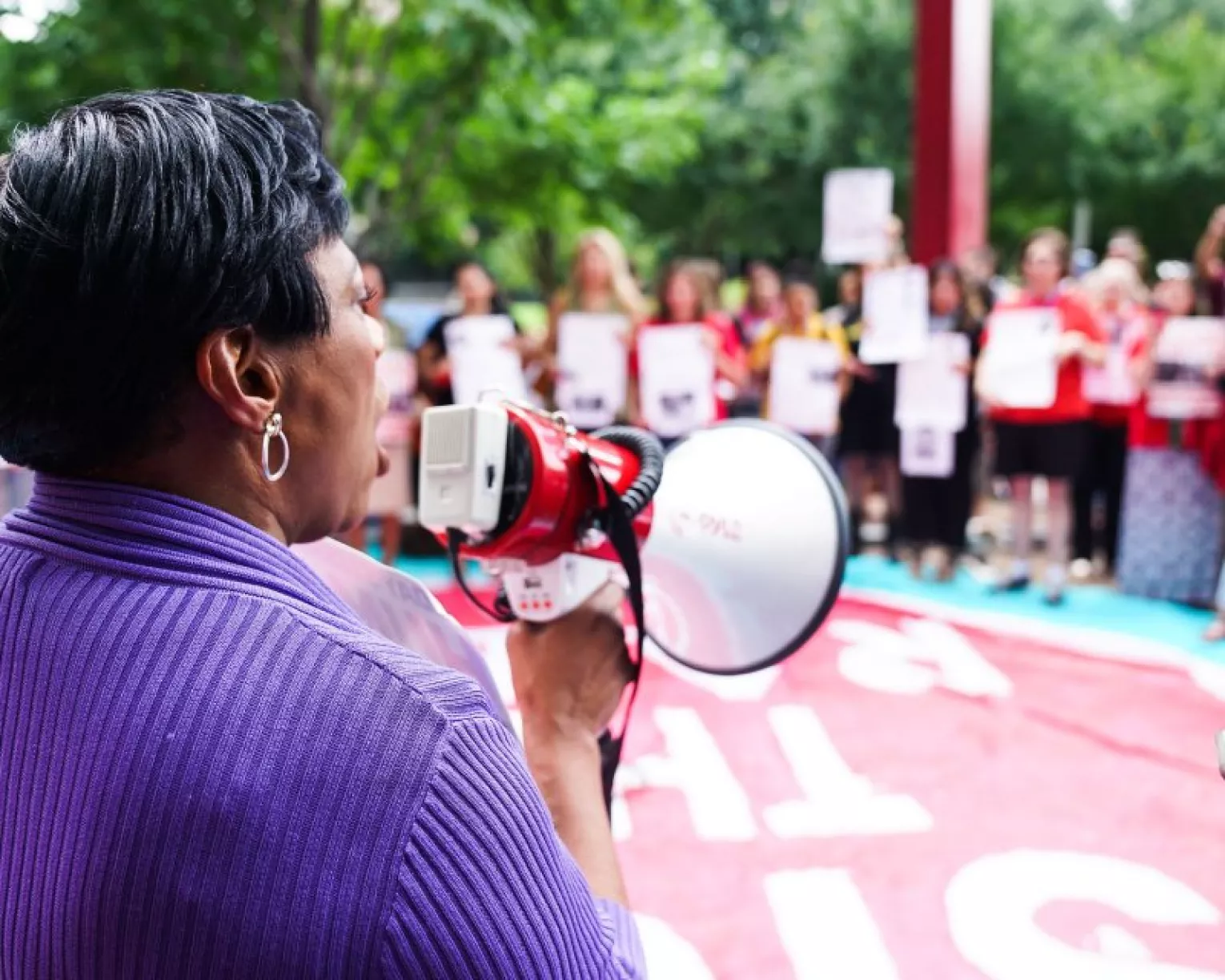Education Funding and Budget

Article I of the Constitution invests Congress with the power of the purse. It also specifies that no public monies are to be spent unless they are appropriated by Congress.
However, the Trump Administration’s actions have made it harder to reach a funding deal to keep the government open. The Trump Administration’s actions to break the March 2025 funding deal are undermining lawmakers’ ability to negotiate future funding deals, which have led to our current government shutdown. This year the executive branch has illegally withheld billions in appropriated funds for education, public health, medical research and more. Additionally, there have been unilateral, illegal rescissions by this Administration, including withholding funds until they expire despite being legally obligated to spend the money.
Lawmakers cannot make a deal if one side refuses to honor it. To ensure funds appropriated by Congress are spent in accordance with the law, include guardrails in FY2026 education funding bills.
Here's What's at Stake in your State
-
Alabama
IDEA Funding
$235.7 MTitle I Funding
$302.8 MPell Grants
$558 MCareer & Technical Education Grants
$24.5 M -
Alaska
IDEA Funding
$49.3 MTitle I Funding
$53.3 MPell Grants
$38.8 MCareer & Technical Education Grants
$5.9 M -
Arizona
IDEA Funding
$267.1 MTitle I Funding
$327.8 MPell Grants
$1,561.9 BCareer & Technical Education Grants
$34.3 M -
Arkansas
IDEA Funding
$149.8 MTitle I Funding
$176.2 MPell Grants
$1,561.9 BCareer & Techincal Education Grants
$14.9 M -
California
IDEA Funding
$1,573.7 BTitle I Funding
$2,236.8 BPell Grants
$4,683.7 BCareer & Technical Education Grants
$142.4 M -
Colorado
IDEA Funding
$214.4 MTitle I Funding
$182.9 MPell Grants
$616.3 MCareer & Technical Education Grants
$21.4 M -
Connecticut
IDEA Funding
$169.5 MTitle I Funding
$155 MPell Grants
$421 MCareer & Technical Education Grants
$12.3 M -
Delaware
IDEA Funding
$48.3 MTitle I Funding
$58.8 MPell Grants
$80.4 MCareer & Technical Education Grants
$5.9 M -
Florida
IDEA Funding
$838.2 MTitle I Funding
$1,002.3 BPell Grants
$2,499.8 BCareer & Technical Education Grants
$82.8 M -
Georgia
IDEA Funding
$451.1 MTitle I Funding
$610.2 MPell Grants
$1,372.7 BCareer & Technical Education Grants
$51.6 M -
Hawaii
IDEA Funding
$53 MTitle I Funding
$69.9 MPell Grants
$81.1 MCareer & Technical Education Grants
$7 M -
Idaho
IDEA Funding
$76.6 MTitle I Funding
$65.1 MPell Grants
$210.2 MCareer & Technical Education Grants
$8.8 M -
Illinois
IDEA Funding
$641.5 MTitle I Funding
$794.5 MPell Grants
$1,165.5 BCareer & Technical Education Grants
$50.8 M -
Indiana
IDEA Funding
$337.2 MTitle I Funding
$281.1 MPell Grants
$667.8 MCareer & Technical Education Grants
$32.4 M -
Iowa
IDEA Funding
$155.7 MTitle I Funding
$110.6 MPell Grants
$275.7 MCareer & Technical Education Grants
$14.5 M -
Kansas
IDEA Funding
$141.3 MTitle I Funding
$125.1 MPell Grants
$286.7 MCareer & Technical Education Grants
$13.1 M -
Kentucky
IDEA Funding
$215.3 MTitle I Funding
$281.3 MPell Grants
$488.3 MCareer & Technical Education Grants
$22 M -
Louisiana
IDEA Funding
$240.6 MTitle I Funding
$394.7 MPell Grants
$593.1 MCareer & Technical Education Grants
$24.8 M -
Maine
IDEA Funding
$70.9 MTitle I Funding
$60.9 MPell Grants
$113.3 MCareer & Technical Education Grants
$7 M -
Maryland
IDEA Funding
$265.7 MTitle I Funding
$323.6 MPell Grants
$484.5 MCareer & Technical Education Grants
$20.8 M -
Massachusetts
IDEA Funding
$360.3 MTitle I Funding
$285.4 MPell Grants
$557.4 MCareer & Technical Education Grants
$23.4 M -
Michigan
IDEA Funding
$502.9 MTitle I Funding
$559.4 MPell Grants
$831 MCareer & Technical Education Grants
$46.8 M -
Minnesota
IDEA Funding
$250.6 MTitle I Funding
$194.5 MPell Grants
$522.3 MCareer & Technical Education Grants
$21.5 M -
Mississippi
IDEA Funding
$154.6 MTitle I Funding
$241.5 MPell Grants
$397.9 MCareer & Technical Education Grants
$16 M -
Missouri
IDEA Funding
$290 MTitle I Funding
$272.3 MPell Grants
$517.5 MCareer & Technical Education Grants
$28.3 M -
Montana
IDEA Funding
$50 MTitle I Funding
$57.8 MPell Grants
$65.3 MCareer & Technical Education Grants
$6.8 M -
Nebraska
IDEA Funding
$97 MTitle I Funding
$90.5 MPell Grants
$180.6 MCareer & Technical Education Grants
$8.3 M -
Nevada
IDEA Funding
$104.4 MTitle I Funding
$161 MPell Grants
$200 MCareer & Technical Education Grants
$12.8 M -
New Hampshire
IDEA Funding
$61.1 MTitle I Funding
$47 MPell Grants
$326.5 MCareer & Technical Education Grants
$7 M -
New Jersey
IDEA Funding
$459.5 MTitle I Funding
$457.2 MPell Grants
$833.7 MCareer & Technical Education Grants
$29.1 M -
New Mexico
IDEA Funding
$115.5 MTitle I Funding
$146.1 MPell Grants
$186.9 MCareer & Technical Education Grants
$10.5 M -
New York
IDEA Funding
$973.3 MTitle I Funding
$1,489.3 BPell Grants
$2,086.7 BCareer & Technical Education Grants
$64.9 M -
North Carolina
IDEA Funding
$444.2 MTitle I Funding
$513.9 MPell Grants
$1,047.1 BCareer & Technical Education Grants
$48.7 M -
North Dakota
IDEA Funding
$42.5 MTitle I Funding
$52.5 MPell Grants
$56.8 MCareer & Technical Education Grants
$5.9 M -
Ohio
IDEA Funding
$553.6 MTitle I Funding
$657.3 MPell Grants
$910.2 MCareer & Technical Education Grants
$52.7 M -
Oklahoma
IDEA Funding
$192.4 MTitle I Funding
$229.1 MPell Grants
$378.8 MCareer & Technical Education Grants
$18.4 M -
Oregon
IDEA Funding
$170 MTitle I Funding
$167.7 MPell Grants
$315.7 MCareer & Technical Education Grants
$17.4 M -
Pennsylvania
IDEA Funding
$553.7 MTitle I Funding
$735.7 MPell Grants
$960.3 MCareer & Technical Education Grants
$51 M -
Rhode Island
IDEA Funding
$56.8 MTitle I Funding
$59.4 MPell Grants
$122.7 MCareer & Technical Education Grants
$7 M -
South Carolina
IDEA Funding
$236.3 MTitle I Funding
$280 MPell Grants
$449.9 MCareer & Technical Education Grants
$24.5 M -
South Dakota
IDEA Funding
$48,100,000Title I Funding
$57.8 MPell Grants
$66.4 MCareer & Technical Education Grants
$30.7 M -
Tennessee
IDEA Funding
$308.6 MTitle I Funding
$335.4 MPell Grants
$696.9 MCareer & Technical Education Grants
$30.7 M -
Texas
IDEA Funding
$1,294.6 MTitle I Funding
$1,851.2 BPell Grants
$3,370.9 BCareer & Technical Education Grants
$128.8 M -
Utah
IDEA Funding
$153.6 MTitle I Funding
$80.5 MPell Grants
$3,370.9 MCareer & Technical Education Grants
$128.8 M -
Vermont
IDEA Funding
$41.1 MTitle I Funding
$42.7 MPell Grants
$48 MCareer & Technical Education Grants
$5.9 M -
Virginia
IDEA Funding
$370 MTitle I Funding
$325.7 MPell Grants
$848.4 MCareer & Technical Education Grants
$32.5 M -
Washington
IDEA Funding
$296.1 MTitle I Funding
$306.6 MPell Grants
$443 MCareer & Technical Education Grants
$26 M -
Washington, D.C.
IDEA Funding
$27 MTitle I Funding
$57 MPell Grants
$244.9 MCareer & Technical Education Grants
$5.9 M -
West Virginia
IDEA Funding
$97.4 MTitle I Funding
$115.9 MPell Grants
$245.9 MCareer & Technical Education Grants
$9.8 M -
Wisconsin
IDEA Funding
$269.1 MTitle I Funding
$227.9 MPell Grants
$413.6 MCareer & Technical Education Grants
$25.5 M -
Wyoming
IDEA Funding
$43.2 MTitle I Funding
$47.3 MPell Grants
$36 MCareer & Technical Education Grants
$5.9 M
About Federal Funding for Education
Of the total amount spent on education in the United States each year, the federal government accounts for less than 10 percent. The rest comes from state and local governments and other non-federal sources. But the federal role is more than money. It’s also about protecting civil rights and ensuring equal opportunity for all students.
Federal aid for education comes with requirements. To get it, states must follow laws like ESSA, the current version of the 1965 Elementary and Secondary Education Act, the cornerstone of the federal role in education. Different sections of the law target different groups—for example, Title 1 covers schools with high percentages of low-income students.
The U.S. Department of Education describes the federal role in education as “a kind of ‘emergency response system,’ a means of filling gaps in State and local support for education when critical national needs arise.”
The Individuals with Disabilities Education Act reflects the federal government’s commitment to provide a free, appropriate public education to students with disabilities and paying 40 percent of the additional cost—a commitment that remains unfulfilled.
NEA is a strong advocate for increasing the federal investment in Department of Education programs and ensuring that they help the students most in need of support and resources.
NEA also advocates for education-related programs administered by other federal agencies—for example, USDA school meals programs and CHIP, the Children’s Health Insurance Program.
The Reconciliation Process
Generally, because of the filibuster, it takes 60 votes to pass a bill in the Senate. Reconciliation plays by special rules that require only a simple majority—51 votes instead of the usual 60, or just 50 votes when the vice president is of the same party as the majority.
The first step is adopting an overall framework. In February, the House took that step with a resolution calling for $1.7 trillion in spending cuts, $4.5 trillion in tax cuts, and a $2.8 trillion increase in the deficit—a vast understatement, according to the Penn Wharton Budget Model.
Over the long term, it is counterproductive to pay for tax cuts for the wealthy and corporations by slashing investments in our students—America’s future leaders and workforce. Nevertheless, that is precisely what is planned.
References
Downloads
- FY 2024 Appropriations Summary.pdfPDF
- Taxes One Pager.pdfPDF
- Reconciliation Explainer.pdfPDF
- Vouchers One Pager.pdfPDF
- Medicaid CHIP One Pager.pdfPDF
- One Pager on Reconciliation June 2025.pdfPDF
- CEF's FY 2026 Funding Table - President's 2026 budget v 2024 (05.30.25) .pdfPDF
- FY 2026 Education Funding One Pager.pdfPDF
Use Your Educator Voice.
